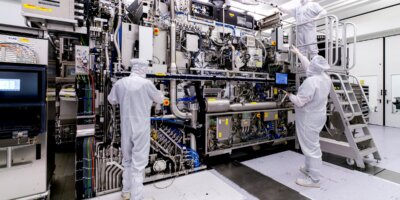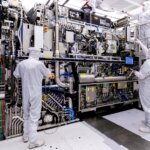Spectroscopic Elements, optical elements with three-dimensional microstructure, made with NIL process (image by Canon)
Canon gives China hope in semiconductor manufacturing process
- Deep ultraviolet lithography machines are a key component of the semiconductor manufacturing process.
- ASML has been dominating the industry.
- Canon has made a breakthrough with lithography machines.
While there are many companies in the semiconductor manufacturing market, some components are the speciality of only a handful of companies. In fact, the semiconductor manufacturing process can be divided into two main stages – design and manufacturing.
Companies that focus only on design are referred to as fabless firms. These include companies like Qualcomm, Nvidia and AMD. Companies that focus on manufacturing are called foundries. Examples of foundries include GlobalFoundries, TSMC, Micron Technologies and SMIC. There are also semiconductor companies that do both. They are called integrated device manufacturers (IDMs). These companies include Intel, Samsung and Texas Instruments.
And then there is the semiconductor manufacturing process supply chain, which involves components from all over the world to make a chip. The semiconductor supply chain remains the most crucial element in the entire process.
The Covid-19 pandemic witnessed unprecedented disruptions to the semiconductor supply chain. Since then, companies have been working to solve their supply chain issues by finding alternatives to speed up the manufacturing process. Some companies have even started to develop their own chips to deal with the issue.
But apart from the pandemic, the trade conflict between the US and China has also affected the production of chips. China is one of the largest manufacturers of semiconductor components for American companies. At the same time, a lot of American brands also have plants operating in China to build their products.
Canon’s new innovation.
Sanctions by the US government on the export of semiconductor materials to China continue to be a concern for most companies. One company caught in this crossfire is ASML. The Dutch company is known for its immersion deep ultraviolet lithography machines, which are a key component of the semiconductor manufacturing process.
Under the restrictions by the US, Dutch export control rules will forbid also ASML from maintaining, repairing and providing spare parts for controlled equipment without specific government approval.
According to a report by The Diplomat, ASML is the world’s largest producer of photolithography machines, which use a light source to etch electronic pathways onto silicon wafers. This process is an essential step in creating the semiconductors that are sold by the likes of TSMC, Intel and Nvidia, which all purchase ASML machines for their chipmaking.
The report also stated that ASML is currently the only company in the world that can manufacture extreme ultraviolet (EUV) machines. Its EUVs are sold for up to US$200 million per machine. The newest model in production, the High NA EUV machine, is valued at over US$300 million and is roughly the size of a truck.
An FPA-1200NZ2C in operation. (image by Canon)
Canon looks to boost semiconductor manufacturing process
Now, Canon seems to have made a breakthrough with lithography machines. On October 13th, Canon launched the FPA-1200NZ2C nanoimprint semiconductor manufacturing equipment. The machine is capable of executing circuit pattern transfer, the most important semiconductor manufacturing process.
Canon has already been involved in the semiconductor manufacturing process with its existing photolithography systems. By introducing nanoimprint lithography (NIL) technology, Canon will be able to reproduce intricate circuit patterns on the wafer without going through an optical mechanism. It allows for the creation of complex two- or three-dimensional circuit patterns in a single imprint, potentially reducing the cost of ownership.
Canon’s NIL technology achieves a minimum linewidth of 14 nm, meeting the requirements for producing advanced 5-nm-node logic semiconductors. With advancements in mask technology, it is anticipated that this technology could enable circuit patterning with a minimum linewidth of 10 nm, equivalent to a 2 nm node. The new product incorporates state-of-the-art environment control technology, minimizing contamination by fine particles within the equipment.
Put simply, this technology enables the precise alignment crucial for manufacturing semiconductors with several layers, reducing defects caused by fine particles. It facilitates the creation of intricate circuits, contributing to the production of cutting-edge semiconductor devices. Unlike current photolithography equipment, this new product doesn’t require a special wavelength light source for fine circuits, significantly reducing power consumption and contributing to CO2 reduction.
Additionally, Canon says that the FPA-1200NZ2C can be applied to various uses, including metalenses for XRs, featuring microstructures at the nanometer scale, in addition to logic and other semiconductor devices.
Is there hope for China’e semiconductor manufacturing process? (Image by Shutterstock)
Hope for China’s semiconductor industry?
Since the sanctions imposed by the US, China has already been working round the clock on developing its own equipment. The world’s most populous country has set itself a target of reaching 40% self-sufficiency in chips by 2020 and 70% by 2025. However, it has not even passed the 20% mark yet.
Despite research and developments in local Chinese universities, the country is still struggling to be self-sufficient and continues to import around US$400 billion worth of semiconductors annually.
But according to a report by Bloomberg, Canon’s new machine may open up a new front in the US-China trade war. Currently, the import of EUV machines into China is prohibited by trade sanctions. And until now, importing EUV machines has been the only reliable way to domestically fabricate 5nm chips and smaller.
The Japanese firm’s technique skips photolithography altogether and instead impresses the desired circuit pattern onto the silicon wafer. Because of its novelty, Bloomberg believes that it’s unlikely to be expressly forbidden by existing trade curbs.
That could drive a tree trunk through the US’ sanction plans – or at least force it to steer another set of openly Sinophobic restrictions into place.
Things could be about to get interesting in the world of semiconductor manufacturing again.
READ MORE
- 3 Steps to Successfully Automate Copilot for Microsoft 365 Implementation
- Trustworthy AI – the Promise of Enterprise-Friendly Generative Machine Learning with Dell and NVIDIA
- Strategies for Democratizing GenAI
- The criticality of endpoint management in cybersecurity and operations
- Ethical AI: The renewed importance of safeguarding data and customer privacy in Generative AI applications




